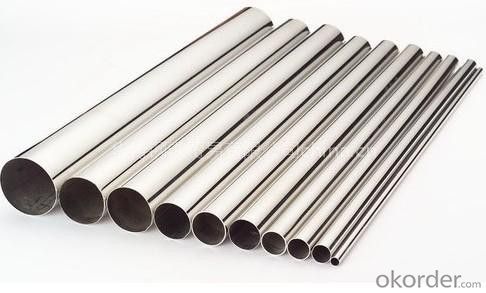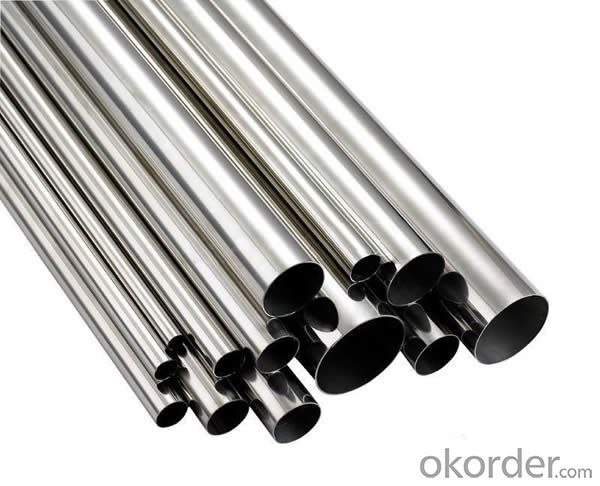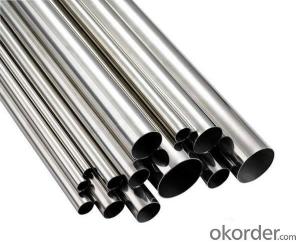Boiler Heat Exchange Stainless Steel Pipe 2205
- Loading Port:
- Tianjin
- Payment Terms:
- TT OR LC
- Min Order Qty:
- 1 m.t.
- Supply Capability:
- 1000 m.t./month
OKorder Service Pledge
OKorder Financial Service
You Might Also Like
Product Description:
1、Structure of Boiler Heat Exchange Stainless Steel Pipe 2205 ASTM A213 Description:
Boiler Heat Exchange stainless steel pipe is often used in the heating system. Heating system, or those stored energy (such as solar energy) in the form of heat, need to be built with the material that can withstand temperatures up to 550 degrees Celsius. High chromium molybdenum welded steel pipe can work in the extreme, which maintain as the ideal material for the construction of power station.
2、Main Features of Boiler Heat Exchange Stainless Steel Pipe 2205 ASTM A213:
• High manufacturing accuracy
• High strength
• Small inertia resistance
• Strong heat dissipation ability
• Good visual effect
•Reasonable price
3、Boiler Heat Exchange Stainless Steel Pipe 2205 ASTM A213 Images:



4、Boiler Heat Exchange Stainless Steel Pipe 2205 ASTM A213 Specification:
1)Commodity: heat exchanger pipe
2))Material: 304,316L,304L,316,321,310S,etc
3)Thickness:0.5-100mm
4)Length: 1-14m
| Material Grade | 304,304L,316 ,316L,321,310S,2205,904and so on. |
| Standard | ASTM A312, A554, A249, A269 and A270,ect |
| DIN 17456-85 , DIN 17458-85, DIN 17459-92,ect | |
| JIS G3446-1994, JIS G3448-1997, JIS G3459-1997, JIS G3463-1994,ect | |
| GB13296-1991, GB14975-2002, GB14976-2002,ect | |
| Outer Diameter | 13.7-2020mm |
| Thickness | 0.5-50mm |
| Length | 1m -12m or as customers' request |
| Polish | 180G, 320G, 400G Satin / Hairline |
| 400G, 500G, 600G or 800G Mirror finish | |
| Test | eddy current inspection, ultrasonic inspection, X-ray inspection, real-time imaging, hydrostatic test, spectral analysis, intergranular corrosion, water pressure test, and mechanical property testing facilities. |
| Payment | 1) by L/C at sight, |
| 2) 30% deposit, 70% balance before Shipping. | |
| Delivery time | A.7 days if this goods is stock goods. |
| B.25 days if this goods will be produced after order | |
| Validity | Valid time is 3 days for price usually. |
| Payment terms | FOB Tianjin |
| MOQ | 1 ton |
| Capacity | 1000 ton per month |
| Certificate | ISO, SGS, and third part inspection |
| Applications | the products are widely used in chemical industry, condenser pipe, heat exchanger, petroleum, shipping military, environment protection, high temperature resistant, low temperature resistant, corrosion resistant and so on. |
| packing details | 1) Wooden-box Package. 2) The Wooden Frame Packing. 3) Intertexture Cloth Packaging with the Iron Sheet Bonding and the Two Terminals Covered With Plastic Dome. |
5、FAQ of Boiler Heat Exchange Stainless Steel Pipe 2205 ASTM A213 :
①How is the quality of your products?
Our products are manufactured strictly according to national and internaional standard, and we take a test on every pipe before delivered out. If you want see our quality certifications and all kinds of testing report, please just ask us for it.
Guaranteed: If products’ quality don’t accord to discription as we give or the promise before you place order, we promise 100% refund.
②How about price?
Yes, we are factory and be able to give you lowest price below market one, and we have a policy that “ for saving time and absolutely honest business attitude, we quote as lowest as possible for any customer, and discount can be given according to quantity”,if you like bargain and factory price is not low enough as you think, just don’t waste your time.Please trust the quotation we would give you, it is professional one.
③Why should you chose us?
Chose happens because of quality, then price, We can give you both.Additionally, we can also offer professional products inquiry, products knowledge train(for agents), smooth goods delivery, exellent customer solution proposals.Our service formula: good quality+good price+good service=customer’s trust
SGS test is available, customer inspection before shipping is welcome, third party inspection is no problem.
Any question, pls feel free to contact us !
- Q:Are stainless steel pipes resistant to corrosion?
- Yes, stainless steel pipes are highly resistant to corrosion due to the presence of chromium in their composition, which forms a protective layer on the surface of the pipes, preventing rusting and corrosion.
- Q:Can stainless steel pipes be insulated with polyurethane?
- Yes, stainless steel pipes can be insulated with polyurethane. Polyurethane insulation is a common choice for insulating pipes due to its excellent thermal properties and ability to adhere to various surfaces, including stainless steel. It helps to prevent heat loss or gain in the pipes, providing energy efficiency and protection against condensation.
- Q:Can stainless steel pipes be used for oil and gas applications?
- Yes, stainless steel pipes can be used for oil and gas applications. Stainless steel possesses excellent corrosion resistance properties, making it suitable for handling corrosive fluids such as oil and gas. It also has high strength and durability, making it a reliable choice for these applications. Additionally, stainless steel pipes can withstand high temperatures and pressures, making them well-suited for oil and gas transportation and processing.
- Q:What is the maximum pressure that stainless steel pipes can handle?
- The maximum pressure that stainless steel pipes can handle depends on various factors such as the grade of stainless steel, the pipe's dimensions, the temperature of the fluid being transported, and the specific application of the pipe. Stainless steel pipes are known for their high strength and corrosion resistance, making them suitable for a wide range of applications where pressure is a concern. The most commonly used stainless steel grades for pipes are 304 and 316, which have different mechanical properties and maximum pressure ratings. For instance, type 304 stainless steel pipes have a maximum pressure rating of around 14,000 psi (pounds per square inch) at room temperature. However, this rating can vary depending on the pipe's wall thickness and diameter. Thicker pipes with larger diameters can generally handle higher pressures. On the other hand, type 316 stainless steel pipes are known for their increased corrosion resistance, especially in environments with chloride ions. They have a slightly higher maximum pressure rating compared to type 304, usually around 15,000 psi at room temperature. It is essential to note that the maximum pressure rating decreases as the temperature of the fluid increases. Stainless steel's mechanical properties change with temperature, and its strength reduces as it gets hotter. Therefore, it is crucial to consider the maximum operating temperature and determine the appropriate pressure rating accordingly. Additionally, it is always recommended to consult relevant industry standards, codes, and regulations, such as ASME B31.3 for process piping or ASME B31.1 for power piping, as they provide detailed guidelines on the maximum pressure ratings for stainless steel pipes in various applications. To ensure the safety and reliability of stainless steel pipes under high-pressure conditions, it is advisable to consult with a qualified engineer or a specialist in stainless steel piping systems. They can evaluate the specific requirements of your application and provide accurate information regarding the maximum pressure that stainless steel pipes can handle.
- Q:What is the difference between stainless steel pipes and PVC pipes?
- Stainless steel pipes are made from a durable and corrosion-resistant material, while PVC pipes are made from a lightweight and cost-effective plastic. Stainless steel pipes are suitable for high-pressure and high-temperature applications, while PVC pipes are commonly used for water supply and drainage systems. Additionally, stainless steel pipes have a longer lifespan and can withstand harsh environmental conditions, whereas PVC pipes may degrade over time and are more prone to cracking or breaking.
- Q:How do you calculate the wall thickness for stainless steel pipes under external pressure?
- To calculate the wall thickness for stainless steel pipes under external pressure, you need to consider various factors such as the material properties, design codes, and the applied external pressure. Here is a general approach to calculating the wall thickness: 1. Determine the design pressure: The first step is to identify the external pressure that the stainless steel pipe will be subjected to. This pressure can be due to factors like fluid flow, environmental conditions, or operational requirements. 2. Determine the material properties: Stainless steel pipes have different grades, each with its own mechanical properties. Consult the material specifications to obtain the values for the yield strength (Sy) and ultimate tensile strength (Su) of the specific stainless steel grade you are working with. 3. Determine the allowable stress: The allowable stress (Sa) is the maximum stress that the material can sustain under the given conditions. It is usually provided by design codes or standards such as ASME B31.3 for process piping or ASME Section VIII for pressure vessels. 4. Calculate the design pressure thickness: Use the following formula to calculate the design pressure thickness (t): t = (P * D) / (2 * Sa) where P is the design pressure and D is the outside diameter of the stainless steel pipe. 5. Determine the corrosion allowance: Since stainless steel is prone to corrosion, it is important to consider a corrosion allowance to ensure the longevity of the pipe. The corrosion allowance is typically specified by the design codes or industry standards. 6. Calculate the final wall thickness: Add the corrosion allowance to the design pressure thickness calculated in step 4 to obtain the final wall thickness. It is important to note that this is a general approach, and specific design codes or standards may have additional requirements or factors to consider. Therefore, it is recommended to consult the relevant design codes, standards, or a qualified engineer to ensure accurate and safe calculations for your specific application.
- Q:How do you prevent corrosion in stainless steel pipes?
- To prevent corrosion in stainless steel pipes, there are a few measures that can be taken. Firstly, it is important to ensure that the stainless steel pipes are made from a high-quality grade of stainless steel. Different grades of stainless steel have varying levels of resistance to corrosion, so selecting the appropriate grade for the specific application is crucial. Secondly, regular cleaning and maintenance of the stainless steel pipes is essential. This involves removing any dirt, debris, or contaminants that can potentially cause corrosion. Cleaning can be done using mild soap or detergent, followed by rinsing with clean water and drying the pipes thoroughly. Moreover, it is advisable to avoid using abrasive cleaners or scrubbers that can scratch the surface of the stainless steel pipes, as this can create small crevices where corrosion can occur. Instead, soft cloth or sponge should be used for cleaning. Additionally, it is essential to protect stainless steel pipes from exposure to corrosive substances or environments. This can be achieved by applying a protective coating or using a corrosion-resistant paint on the pipes. This barrier will prevent direct contact between the stainless steel and corrosive substances, reducing the risk of corrosion. Furthermore, maintaining proper water chemistry is important for preventing corrosion in stainless steel pipes used for plumbing applications. Monitoring and controlling the pH level, hardness, and alkalinity of the water can help minimize the corrosive effects on the pipes. Lastly, ensuring proper installation and design of stainless steel pipes is crucial. This includes avoiding tight bends or sharp corners, which can trap moisture and lead to corrosion. Proper insulation and ventilation should also be considered to prevent condensation and subsequent corrosion. By following these preventive measures, corrosion in stainless steel pipes can be significantly reduced, ensuring their longevity and optimal performance.
- Q:Can stainless steel pipes be used for wastewater pumping stations?
- Indeed, stainless steel pipes are suitable for use in wastewater pumping stations. Renowned for their durability, resistance to corrosion, and lengthy lifespan, stainless steel pipes prove to be an exceptional selection for wastewater applications. Given that wastewater pumping stations frequently handle corrosive and abrasive fluids, stainless steel pipes possess the ability to endure these harsh circumstances without deteriorating or causing contamination. Furthermore, stainless steel pipes are effortlessly cleaned and maintained, a critical feature for wastewater systems. In summary, stainless steel pipes represent a dependable and fitting choice for wastewater pumping stations.
- Q:What are the different types of stainless steel pipe insulation?
- There are several different types of stainless steel pipe insulation available on the market. These types can vary in terms of their material composition, construction, and insulation properties. One common type is fiberglass insulation, which consists of a layer of fiberglass material wrapped around the stainless steel pipe. This type of insulation is known for its excellent thermal insulation properties and its ability to withstand high temperatures. It is also resistant to moisture, making it suitable for both indoor and outdoor applications. Another type is foam insulation, which is made from a foamed plastic material such as polyurethane or polystyrene. Foam insulation is lightweight and easy to install, and it provides good thermal insulation as well as acoustic insulation. It is commonly used in residential and commercial buildings to insulate hot water pipes and HVAC systems. Additionally, there are elastomeric insulation materials, which are flexible rubber-like materials that can be easily wrapped around the stainless steel pipe. These materials are known for their excellent thermal insulation properties and their ability to resist moisture and condensation. Elastomeric insulation is commonly used in refrigeration and air conditioning systems. Finally, there are also pre-insulated stainless steel pipe systems, which consist of a stainless steel pipe already insulated with a layer of insulation material. This type of insulation is commonly used in industrial applications where thermal insulation is critical, such as in chemical plants or oil refineries. In conclusion, the different types of stainless steel pipe insulation include fiberglass insulation, foam insulation, elastomeric insulation, and pre-insulated pipe systems. The choice of insulation type depends on factors such as the application, desired insulation properties, and budget.
- Q:What is the maximum pressure rating for stainless steel pipe fittings?
- There are several factors that contribute to the maximum pressure rating of stainless steel pipe fittings, including the material grade, size, and temperature. In general, stainless steel pipe fittings have the ability to handle high-pressure applications due to their strength and resistance to corrosion. The pressure rating of these fittings can vary greatly, ranging from 150 psi to as high as 10,000 psi, depending on the specific fitting and its intended use. To determine the maximum pressure rating for a particular stainless steel pipe fitting, it is important to refer to the manufacturer's documentation or industry standards such as ASME B16.11 or ASME B16.9. Additionally, when working with high-pressure systems, other factors such as the sealing method, compatibility with the conveyed fluid, and any necessary safety precautions must be taken into consideration.
1. Manufacturer Overview |
|
|---|---|
| Location | |
| Year Established | |
| Annual Output Value | |
| Main Markets | |
| Company Certifications | |
2. Manufacturer Certificates |
|
|---|---|
| a) Certification Name | |
| Range | |
| Reference | |
| Validity Period | |
3. Manufacturer Capability |
|
|---|---|
| a)Trade Capacity | |
| Nearest Port | |
| Export Percentage | |
| No.of Employees in Trade Department | |
| Language Spoken: | |
| b)Factory Information | |
| Factory Size: | |
| No. of Production Lines | |
| Contract Manufacturing | |
| Product Price Range | |
Send your message to us
Boiler Heat Exchange Stainless Steel Pipe 2205
- Loading Port:
- Tianjin
- Payment Terms:
- TT OR LC
- Min Order Qty:
- 1 m.t.
- Supply Capability:
- 1000 m.t./month
OKorder Service Pledge
OKorder Financial Service
Similar products
New products
Hot products
Hot Searches
Related keywords




























